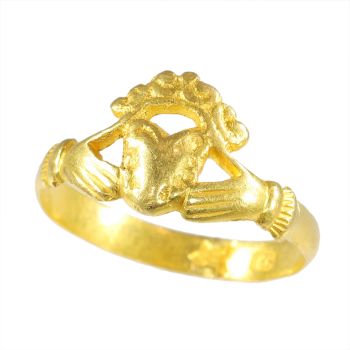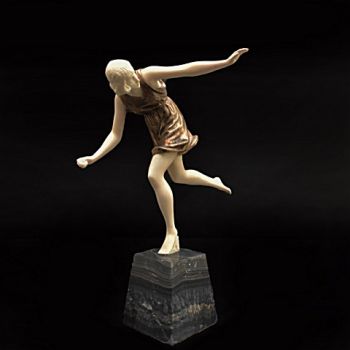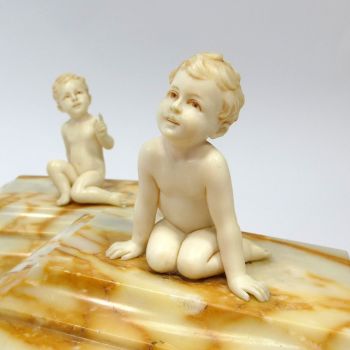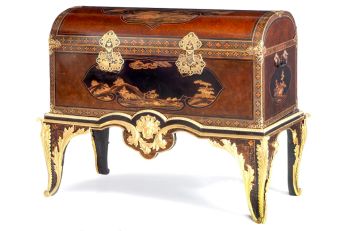A gem-set ivory sculpture of an Ottoman sultan 1700 - 1750
Artista Desconocido
HuesoGemasMarfilPiedra preciosa
25 cm
Precio a consultar
Zebregs & Röell - Fine Art - Antiques
- Sobre la obra de arteProbably Southern Germany, early 18th century, the base 19th century
The figure, which is dressed in a long, elaborately detailed partially gem-set robe with ornamental designs along the edges and is wearing a turban adorned with a feather and further inlaid with gemstones, is mounted on an octagonal base of later date, made of alternating panels of ivory and tortoiseshell.
H. 25.5 cm (incl. base)
Provenance:
Private collection, Brussels
This figure represents the fascination with ‘Turquerie’ in 18th-century Europe, where Ottoman themes were in vogue in art, design, and architecture. This rage was also called ‘Turkomania’. The depiction of this sultan shows the blend of admiration and exoticism that characterised European views of the Ottoman Empire during this period. Such sculptures were often produced for wealthy collectors who sought high-quality representations of Eastern rulers, catering to the demand. The present sculpture was rather exclusive, for the gems (amongst which diamonds) are typically Ottoman-cut. They might well have been spoils from the Battle of Vienna, where the Ottomans were defeated after two months of siege, in 1683. - Sobre el artista
Puede suceder que un artista o creador sea desconocido.
Algunas obras no deben determinarse por quién está hecho o por (un grupo de) artesanos. Algunos ejemplos son estatuas de la Antigüedad, muebles, espejos o firmas que no son claras o legibles, pero también algunas obras no están firmadas en absoluto.
También puedes encontrar la siguiente descripción:
•"Atribuido a …." En su opinión, probablemente una obra del artista, al menos en parte.
•“Estudio de….” o “Taller de” En su opinión, una obra ejecutada en el estudio o taller del artista, posiblemente bajo su supervisión
•“Círculo de…” En su opinión, una obra del período del artista que muestra su influencia, estrechamente asociado con el artista pero no necesariamente su alumno.
•"Estilo de …." o “Seguidor de…”. En su opinión, una obra ejecutada al estilo del artista pero no necesariamente por un alumno; puede ser contemporáneo o casi contemporáneo
•"Manera de …." En su opinión una obra al estilo del artista pero de fecha posterior
•"Después …." En su opinión, una copia (de cualquier fecha) de una obra del artista
•“Firmado…”, “Fechado…” o “Inscrito” En su opinión, la obra ha sido firmada/fechada/inscrita por el artista. La adición de un signo de interrogación indica un elemento de duda.
•“Con firma…”, “Con fecha…”, “Con inscripción…” o “Lleva firma/fecha/inscripción” en su opinión la firma/fecha/inscripción ha sido añadida por alguien que no es el artista
¿Está interesado en comprar esta obra de arte?
Artwork details
Related artworks
Artista Desconocido
Anillo belle epoque toi et moi1900
Precio a consultarAns Hemke-Kuilboer Juwelier & Antiquair
1 - 4 / 12Artista Desconocido
A Surinam-themed Amsterdam long-case clock1746 - 1756
Precio a consultarZebregs & Röell - Fine Art - Antiques
 curada por
curada porGallerease Magazine
Artista Desconocido
A Dutch colonial Indonesian betel box with gold mounts1750 - 1800
Precio a consultarZebregs & Röell - Fine Art - Antiques
1 - 4 / 24- 1 - 4 / 24
Artista Desconocido
UN NETSUKE DE MARFIL DE UN HOLANDÉS CON UNA COCKEREL18th century
Precio a consultarZebregs & Röell - Fine Art - Antiques
Artista Desconocido
UNA COLECCIÓN DE CUATRO CAJAS BÍBLICAS DE MARFIL DE SRI LANKAN18th century
Precio a consultarZebregs & Röell - Fine Art - Antiques
Artista Desconocido
Holandeses en miniatura (Netsuke)1700 - 1900
Precio a consultarZebregs & Röell - Fine Art - Antiques
Artista Desconocido
A Dutch colonial Indonesian betel box with gold mounts1750 - 1800
Precio a consultarZebregs & Röell - Fine Art - Antiques
Artista Desconocido
IMPORTANTE Y RARO PINTURA INDIA DE ESTILO DE COMPAÑÍA EN MARFIL QUE REPRESENTA UN DESFILE1850 - 1900
Precio a consultarZebregs & Röell - Fine Art - Antiques
 curada por
curada porDanny Bree
Artista Desconocido
UN NETSUKE MARINE MARFIL DE UN HOLANDÉS CON UN VENTILADOR CHINO18th century
Precio a consultarZebregs & Röell - Fine Art - Antiques
Artista Desconocido
UN PEQUEÑO NETSUKE DE MARFIL DE UN HOLANDÉS CON UN TAMBOR1750 - 1800
Precio a consultarZebregs & Röell - Fine Art - Antiques
1 - 4 / 24Artista Desconocido
Holandeses en miniatura18th century
Precio a consultarZebregs & Röell - Fine Art - Antiques
Artista Desconocido
The bell of the VOC fortress in Jaffna, Sri Lanka1747
Precio a consultarZebregs & Röell - Fine Art - Antiques
 curada por
curada porDanny Bree
Artista Desconocido
An Amazon Indigenous Kayapo feather headdress1950 - 1960
Precio a consultarZebregs & Röell - Fine Art - Antiques
Artista Desconocido
UN MODELO JAPONÉS DE UN NORIMONO, UN PALANQUÍN1650 - 1700
Precio a consultarZebregs & Röell - Fine Art - Antiques
Artista Desconocido
The Stamford Raffles Secretaires.1800 - 1813
Precio a consultarZebregs & Röell - Fine Art - Antiques
Artista Desconocido
PAREJA DE ANTORCHAS O VELAS DE TECA DORADA Y LACADA INDONESIA18th century
Precio a consultarZebregs & Röell - Fine Art - Antiques
Artista Desconocido
Japanese transition-style lacquer coffer 1640 - 1650
Precio a consultarZebregs & Röell - Fine Art - Antiques
Dutch School
Llegada de un holandés de las Indias Orientales a Table Bay18th century
Precio a consultarZebregs & Röell - Fine Art - Antiques
1 - 4 / 12































































































